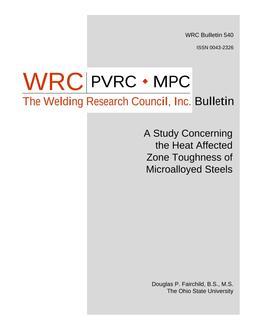Cart 0 Product Products (empty)
No products
To be determined Shipping
$0.00 Total
Product successfully added to your shopping cart
Quantity
Total
There are 0 items in your cart. There is 1 item in your cart.
Total products
Total shipping To be determined
Total
New Reduced price!  View larger
View larger
 View larger
View larger WRC 540
M00022793
New product
WRC 540 Constraint Effects on Fracture Toughness in the Ductile-Brittle Transition Region
Bulletin / Circular by Welding Research Council, Inc., 2014
D. P. Fairchild
In stock
More info
Full Description
The microstructure and fracture performance of four microalloyed linepipe steels (A, B, C, and D) were investigated. Steels A, B, and C were recently manufactured, while steel D was about 30 years old. Simulated CGHAZ specimens were produced by the Gleeble technique using thermal cycles relevant to linepipe welding procedures. The base metals and simulated HAZ's were subjected to a variety of toughness tests including instrumented precracked Charpy (IPC) and standard Charpy-V-notch (CVN) tests. Full transition curves were generated, and transition temperature was used as a measure of cleavage resistance. Upper shelf energy was used as a measure of ductile fracture resistance. The following evaluations were made.1. In some situations, steel D displayed surprisingly good cleavage resistance as compared to the newer steels, but the overwhelming factor controlling steel D's general fracture performance was its poor ductile fracture resistance. The controlling metallurgical features were MnS and silicate stringer inclusions. These inclusions (primarily MnS) debonded from the matrix during mechanical loading. If the orientation of the crack with respect to the inclusions was favorable, the inclusions acted to arrest fracture. Generally, however, the inclusions caused low energy ductile fracture.
2. Fast cooling HAZ's produced stronger microstructures which were lower in ductile fracture resistance than slower cooling HAZ's. The stronger microstructures promoted high triaxial stresses, high void growth rates, and reduced upper shelf toughness. Steel C was particularly susceptible due to a high population of inclusions whose chemistries were consistent with calcium aluminate and/or spinels. The inclusions were poorly bonded to the matrix and this allowed easy microvoid initiation.
3. A correlation between the IPC and CVN transition temperatures was developed for selected data [IPC = 0.98(CVN)+41F]. This correlation cannot be considered universal, and further research is necessary to assess applicability to other steels. Before the CVN technique is considered as a substitute for IPD testing, two issues need to be addressed: (a) commercial Charpy machines are incapable of accurately measuring the upper shelf toughness of modern steels (>300ft-lbs), and (b) the CVN technique generates considerable scatter in the transition region as compared to the IPC technique.
4. Steel A displayed degraded cleavage resistance when processed using Gleeble program 2 (a double thermal cycle simulating an intercritically reheated CGHAZ). LePera?s etchant revealed a significant amount of "island" features located primarily at prior austenite grain boundaries. Double crack, 4-point bead tests and SEM fractography demonstrated that cleavage initiation was cause by these islands. By TEM, these islands were identified as high carbon, twinned martensite. It was concluded that during mechanical loading, the stronger martensite sheds local stress/strain onto the adjacent matrix, and high stress concentration develops at the island/matrix interface. Eventually the martensite (which is tough enough to resist fracture) debonds from the matrix, and this debonding process promotes cleavage initiation in the adjacent matrix.
5. Steel C contained essentially the same volume fraction of martensite islands as steel A, but did not show the same level of toughness degradation. The main difference between these steels was in martensite morpholohy and distribution. Steel A?s marteniste was located primarily in large islands at prior austenite grain boundaries. Steel C's martensite was more evenly distributed throughout the prior austenite grains. It was surmised that steel A's martensite provided more potent cleavage initiation sites. Differences in steel chemistry could not explain steel A vs. steel C. It was concluded that the high inclusion population in steel C promoted a high rate of intragranular austenite nucleation during intercritical reheating, and this caused a finer dispersion of martensite.6. Steel B displayed degraded cleavage fracture resistance in all conditions (base metal and Gleeble simulations), and by all test methods. SEM fractography revealed that cleavage initiation was caused by the fracturing of cuboidal inclusions. Mating fracture faces always contained a broken inclusion half. TEM was used to identify these inclusions as the fcc phase of titanium nitride (TiN: NaCl prototype). The TiN's form in the liquid during steel casting.
7. It was determined that the TiN's are well bonded to the steel matrix. During applied loading, this continuity permits stress transfer from the matrix into the inclusion, and eventually, upon cleavage initiation in the TiN itself, permits crack transfer from the inclusion into the matrix.
8. A variety of tests demonstrated that the TiN's were capable of supporting significant matrix strains without fracturing. By considering the coefficients of thermal expansion and the subject of tessellated stresses in and around inclusion is steel, it was determined that the TiN's reside in a residual compressive stress field. It was concluded that this stress field shields the TiN's from early fracture. Fracture is delayed to a time with the applied loads are high enough to cause catastrophic cleavage.
9. It was conservatively estimated that only 0.0016 wt.% Ti was necessary to create the TiN inclusions in Steel B (about 3% of steel B's total Ti content). It was concluded that two primary factors contributed to the formation of the TiN's: (a) steel B's relatively high Ti content (0.048 wt.%) which increases the driving force for the formation, and (b) the time spent at very high temperatures; i.e. the casting schedule. Because only a small amount of Ti is required to produce sufficient TiN's to reduce cleavage resistance, it is controlling the volume fraction of these inclusions.

